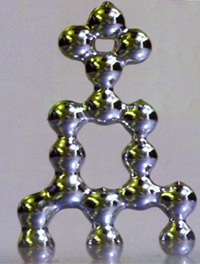A North Carolina State University July 9, 2013 news release (also on EurekAlert) avoids a Terminator 2: Judgment Day movie reference (which I am making) in its description of building 3D structures out of liquid metal,
“It’s difficult to create structures out of liquids, because liquids want to bead up. But we’ve found that a liquid metal alloy of gallium and indium reacts to the oxygen in the air at room temperature to form a ‘skin’ that allows the liquid metal structures to retain their shapes,” says Dr. Michael Dickey, an assistant professor of chemical and biomolecular engineering at NC State and co-author of a paper describing the work.
The researchers developed multiple techniques for creating these structures, which can be used to connect electronic components in three dimensions. White it is relatively straightforward to pattern the metal “in plane” – meaning all on the same level – these liquid metal structures can also form shapes that reach up or down.
One technique involves stacking droplets of liquid metal on top of each other, much like a stack of oranges at the supermarket. The droplets adhere to one another, but retain their shape – they do not merge into a single, larger droplet. Video of the process is available here.
Another technique injects liquid metal into a polymer template, so that the metal takes on a specific shape. The template is then dissolved, leaving the bare, liquid metal in the desired shape. The researchers also developed techniques for creating liquid metal wires, which retain their shape even when held perpendicular to the substrate.
Dickey’s team is currently exploring how to further develop these techniques, as well as how to use them in various electronics applications and in conjunction with established 3-D printing technologies.
The lead researcher, Michael Dickey has produced an image of liquid metal drops in a 3D structure,
Here’s a link to and a citation for the published paper,
3D Printing of Free Standing Liquid Metal Microstructures by Collin Ladd, Ju-Hee So, John Muth, Michael D. Dickey. Article first published online: 4 JUL 2013 DOI: 10.1002/adma.201301400
Copyright © 2013 WILEY-VCH Verlag GmbH & Co. KGaA, Weinheim
This paper is behind a paywall.
For anyone who isn’t familiar with Terminator 2 and doesn’t understand why it was mentioned in the context of this posting, here’s an excerpt from the Wikipedia essay (Note: Links and footnotes have been removed),
The T-1000 is a fictional robotic assassin and the main antagonist in Terminator 2: Judgment Day. Created by the series main antagonist Skynet, the T-1000 is a shapeshifter whose body is composed of a mimetic poly-alloy (liquid metal) body that allows it to assume the form of other objects or people of equal mass. [emphasis mine]
